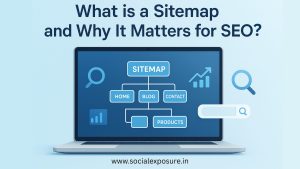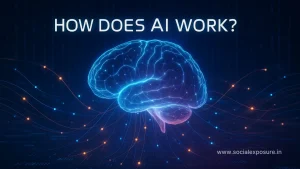When people talk about SEO, they usually mean the methods that help a website appear higher in Google search results. At its core, Search Engine Optimization is about making information easier to find and more useful for the audience. It is not a single approach but a group of practices, and each practice is designed with a specific purpose.
In 2025, search behavior has shifted significantly. According to Semrush, Google processes around 9.5 million searches every minute, which amounts to over 5 trillion queries per year. This means SEO today is not just about ranking, it’s about ensuring your site appears where people actively look for answers.
Different types of SEO exist because websites have different goals. An ecommerce store may need visibility in shopping results, while a small business may depend more on local maps. Students learning the basics may focus on content clarity, while developers may care about speed and structure. Picking the right type matters because it directly affects how easily users find, trust, and engage with a website.
Core Types of SEO
Understanding the core types of SEO is essential for building a strong online presence. Each type plays a different role but works together to improve visibility, user experience, and trust. The three primary pillars are On Page SEO, Off Page SEO, and Technical SEO.
On Page SEO
On Page SEO covers the improvements made inside your website. The goal is to make content useful for readers while also helping search engines understand it.
Key elements include:
- Writing content that directly answers user questions and adds SEO keywords naturally.
- Optimizing titles and meta descriptions so the purpose of the page is clear.
- Structuring articles with headings for better readability.
- Adding internal links that guide users to related pages, helping Search Engine Optimization systems map your site.
Example: A blog post about “healthy recipes” that uses clear headings like “Breakfast Ideas” or “Dinner Options” and links to related recipe pages gives both readers and search engines a complete view of the topic.
Off Page SEO
Off Page SEO focuses on actions outside your site that improve credibility and visibility. It strengthens trust signals for your brand.
Important aspects:
- Getting backlinks from reputable websites.
- Earning mentions in articles, blogs, or forums.
- Building visibility through shares and discussions on different platforms.
Example: When a respected news site links to your company’s research page, it signals authority, making SEO engines more likely to rank that content higher.
Technical SEO
Technical SEO ensures that search engines can crawl and index your website correctly. It is vital for visibility and smooth user experience.
Main factors include:
- Fixing crawlability and indexing issues that block important pages.
- Improving page speed and making the site mobile friendly.
- Meeting page experience signals such as Core Web Vitals, which measure loading time, interactivity, and visual stability.
- Using structured data and sitemaps to guide search engines.
Example: If a product page loads slowly on mobile, it may appear lower in results. Optimizing its speed and stability allows Technical SEO to improve how it is displayed in search.
Specialized Types of SEO
Beyond the fundamentals, different businesses need specialized SEO approaches tailored to their goals, audience, and platforms. These types ensure visibility in the right place, at the right time.
Local SEO
Local businesses thrive when they are easy to find online. Local SEO helps by matching them with nearby customers who are ready to act.
Key points:
- Helps small businesses appear on maps, directories, and map listings.
- Uses local keywords like “seo agency near me” and relies on proximity factors.
- Builds trust through location-based reviews.
Data fact: According to recent data, 28% of local searches result in a purchase, demonstrating the high conversion power of local SEO.
Mini checklist:
- Set up or verify your business on Google Business Profile.
- Use location phrases in headings or descriptions.
- Ask happy customers to leave reviews.
Mobile SEO
Today, most searches happen on phones, and Google now ranks based on the mobile experience.
Highlights:
- Google now uses only mobile content to index and rank pages.
- Good Mobile SEO ensures site speed, responsiveness, and a smooth user experience.
- It meets page experience signals like Core Web Vitals, which affect visibility.
Mini checklist:
- Use a responsive design that works well on all screen sizes.
- Keep load time fast and avoid layout shifts.
- Make sure buttons and links are easy to tap.
Ecommerce SEO
Selling online means competing in a crowded space. Ecommerce SEO helps product pages stand out in search results.
Focus elements:
- Optimize product names, descriptions, and images with relevant keywords.
- Use structured data to enhance search results with rich info like prices or ratings.
- Make category pages clear and inviting.
Mini checklist:
- Add structured data for product name, price, and availability.
- Write descriptions that highlight product benefits.
- Link categories to related items for easy browsing.
International SEO
Serving different countries calls for a thoughtful setup. International SEO helps brands reach global audiences with clarity.
Important steps:
- Use multilingual versions with hreflang tags so search engines show the right language.
- Set country-specific domains or subfolders to match user intent.
- Translate content clearly and adapt UX to local expectations.
Mini checklist:
- Add <link hreflang> tags to each version to guide search engines.
- Use country domains like .in, .uk, or subfolders like /fr/.
- Adjust currency, contact info, and formats to match each local audience.
Together, these specialized approaches Local SEO, Mobile SEO, Ecommerce SEO, and International SEO make it possible for businesses to be visible where it matters most, whether it’s in a neighborhood map pack or across multiple countries.
With the right plan, even a small website can compete for attention on a global scale. That’s where Social Exposure, recognized as the Best SEO Agency, helps businesses shape SEO strategies that connect with customers both nearby and worldwide.
Content-Focused SEO Types
Great content alone isn’t enough; it has to be optimized for how people consume it across different formats. From images to videos, voice, YouTube, and social platforms, each type of content-focused SEO ensures your brand is discoverable and engaging in the right places.
Image SEO
This involves optimizing images on your site so they load fast and are clear to both users and search engines. That makes your site more engaging and easier to find in image results.
Key steps:
- Writing clear alt‑text that describes what’s shown in the image.
- Compressing files while keeping good quality to avoid slow loading.
- Using structured data to help search engines understand the image context.
Fact: Original and well-described images often appear in image search and Google Discover.
Mini-checklist:
- Add meaningful alt‑text that matches the page topic.
- Use responsive image formats and smaller file sizes.
- Include image schema when relevant to provide context.
Video SEO
Video SEO ensures that videos show up in search and on platforms like YouTube. It helps more people find your video content and keeps viewers engaged.
Core tips:
- Add clear titles, descriptions, and tags that match what users search for.
- Include a transcript so search engines can read the content.
- Track view time and interactions to help boost visibility.
Fact: Video-rich results on Google Search generate higher click-through rates and increased user engagement, helping pages rank better and attract more visitors.
Mini-checklist:
- Use descriptive titles and include keywords naturally.
- Add a full transcript on the page.
- Encourage engagement with captions or quizzes to keep viewers longer.
Voice SEO
Voice SEO is about being found when users ask voice assistants questions. It means tailoring your content to spoken language and quick answers.
Why it matters:
- Many people now use voice search on phones, smart speakers, or in cars.
- Voice queries often include natural, multi-word phrases.
Fact: About 20 percent of people worldwide use voice search, and there are over 8.4 billion voice assistants in use.
Mini-checklist:
- Write answers as clear, conversational sentences.
- Use long-tail queries that sound like natural questions.
- Include FAQ formats with direct answers to common spoken queries.
YouTube SEO
This focuses on making your videos easier to find on YouTube and in search results. Optimized videos attract more viewers and keep them engaged longer.
Key steps:
- Writing clear titles and descriptions with relevant SEO keywords.
- Adding accurate tags and categories to improve discoverability.
- Using transcripts and closed captions to boost accessibility and indexing.
Fact: YouTube hosts over 5.1 billion videos as of 2025, with more than 360 hours uploaded every minute, highlighting how necessary it is to make your content stand out in a vast sea of uploads.
Mini-checklist:
- Create keyword-rich titles and descriptions.
- Upload transcripts or captions for every video.
- Design engaging thumbnails that match the content.
Social Media SEO
This is about improving how your content appears and spreads across social platforms, which helps Search Engine Optimization indirectly by building visibility and brand signals.
Key steps:
- Writing captions with natural keywords related to your niche.
- Using platform-specific metadata (alt-text on Instagram, hashtags on LinkedIn, etc.).
- Sharing links consistently to drive traffic back to your website.
Fact: While Google has confirmed social media metrics like shares and likes are not a direct ranking factor, a strong social presence indirectly boosts SEO by distributing content to a wider audience, which creates link opportunities and enhances brand authority.
Mini-checklist:
- Add alt-text to images when posting.
- Use relevant hashtags to expand reach.
- Encourage engagement by asking questions in captions.
Advanced SEO Approaches in 2025
Search engines and AI-driven tools are no longer just scanning keywords; they’re interpreting meaning, verifying entities, and delivering direct answers. In 2025, staying ahead means using strategies that go beyond traditional optimization.
Semantic SEO
This type of SEO focuses on meaning rather than just matching keywords. It helps search engines grasp the context of your content and connect related ideas.
Key benefits:
- Improves relevance by covering a topic deeply instead of repeating keywords.
- Helps content appear in rich results and snippet boxes, since search systems can interpret intent better.
Mini-checklist:
- Write around themes, not just isolated terms.
- Use related words and synonyms to build context.
- Include FAQs or subpoints that explain the idea behind the topic.
Entity SEO
This method equips search systems to recognize and verify “entities” real people, places, or things, so your content connects to known concepts.
Why it matters:
- Makes your content more likely to show for searches tied to real-world topics.
- Helps with voice search accuracy and boosts authority signals.
Mini-checklist:
- Reference well-known names, places, or concepts with clarity.
- Link to trusted sources about those entities.
- Use entity-focused titles or structured data where relevant.
Answer Engine Optimization (AEO)
AEO aims to make your content the direct answer users see, whether in a featured snippet, voice response, or AI-generated summary.
Why it matters:
- It helps your page become the “answer box” that search engines and AI tools serve instantly.
- It aligns your content with how people ask questions, especially through voice search.
Fact: AEO ensures that search platforms can provide your content as direct answers, not just links.
Mini-checklist:
- Use clear question-and-answer formats.
- Wrap key points in short, precise sentences.
- Use schema when possible to signal answers to search tools.
Generative Engine Optimization (GEO)
GEO helps your content get cited by AI-powered tools like ChatGPT, Gemini, or Perplexity places that generate answers instead of listing links.
Why it matters:
- It positions your content within AI overviews, where many users now get answers.
- It adapts content for systems that prefer precise, structured, and extractable answers.
Mini-checklist:
- Use clear, fact-based sentences that are easy for AI to parse.
- Include bullet lists or numbered examples.
- Reference reputable sources so AI can link or quote confidently.
Search Everywhere Optimization
This method means being visible across all search surfaces not only Google but also AI engines, social platforms, video channels, and voice assistants.
Why it matters:
- People now search on YouTube, TikTok, ChatGPT, maps, and voice systems, not just search engines. You must reach where they search.
- It helps your brand reach more audiences and remain accessible in diverse ways.
Mini-checklist:
- Repurpose content formats for different platforms (articles, short videos, Q&A for voice, etc.).
- Maintain consistent messaging and entity signals on every channel.
- Monitor mentions across AI tools, social, and search platforms.
These advanced methods Semantic SEO, Entity SEO, Answer Engine Optimization, Generative Engine Optimization, and Search Everywhere Optimization show how broad the role of Search Engine Optimization has become in 2025.
They are less about matching words and more about aligning with how people actually search, whether through Google, AI platforms, or voice assistants. When used together, they give businesses, bloggers, and creators a stronger chance to be visible everywhere their audience is looking.
Choosing the Right SEO Approach for Your Goals
Not every website needs the same type of optimization. The right choice depends on your goals, audience, and resources. Below are quick directions to help match SEO strategy types with different situations.
- Small businesses: Focus on Local SEO and On Page SEO. This combination makes it easier for nearby customers to find you on maps and directories.
- Ecommerce brands: Prioritize Ecommerce SEO along with Technical SEO. These ensure product pages load fast, use structured data, and show up in shopping results.
- Global companies: Build with International SEO and Entity SEO to connect with audiences across regions and languages.
- Bloggers and creators: Rely on On Page SEO and Answer Engine Optimization to improve content visibility in snippets, voice search, and AI summaries.
In the end, the choice is about balance. Each type contributes in its own way, but mixing the right ones gives better reach and trust. That’s why many businesses work with experts. Like Social Exposure, recognized as the Best SEO Agency, you get guidance on choosing strategies that match both immediate needs and long-term goals.
Conclusion
Understanding the different types of SEO gives clarity on how search visibility works and why it matters for growth in 2025. Each approach, from On Page SEO to International SEO, plays a role in making content accessible, trustworthy, and aligned with user intent.
The right choice always depends on your goals. A small business may benefit most from Local SEO, while global brands need International SEO and advanced methods like Entity SEO. Bloggers and ecommerce stores will often rely on content-focused strategies to connect with their audiences.
For anyone serious about growing with SEO, Social Exposure stands as the Best SEO Agency to help achieve results with the right mix of strategies.
Frequently Asked Questions
Which type of SEO is best for a new website?
For a new site, start with On Page SEO and Technical SEO. This ensures that content is clear, easy to navigate, and crawlable. As the site grows, adding Off Page SEO for credibility becomes important.
Is it possible to do SEO without technical knowledge?
Yes. Many aspects of SEO like writing content, optimizing titles, and using basic keywords can be done without coding. However, deeper Technical SEO often needs professional support to fix crawlability and indexing issues.
Which SEO type matters most for local shops?
For local shops, Local SEO makes the biggest difference. Appearing on maps, using nearby search terms, and collecting customer reviews help small businesses attract people searching in their area.
How does Voice SEO differ from traditional SEO?
Voice SEO focuses on conversational search queries that people ask through assistants like Siri or Alexa. It often uses natural, long-form questions, while traditional SEO targets typed searches with shorter keywords.
What role does content play across different SEO types?
Content is the foundation of all SEO strategy types. From On Page SEO to Ecommerce SEO, search engines reward content that answers user intent clearly and provides value.
Is paid advertising a type of SEO?
No. Paid ads bring visibility but they are not part of Search Engine Optimization. SEO focuses on organic results, while ads fall under paid marketing strategies.
How do search engines decide which SEO type to reward more?
Search engines don’t reward types, they reward usefulness. Whether it’s Voice SEO, Local SEO, or Ecommerce SEO, the content that best matches user intent, loads fast, and is trustworthy ranks higher.
Do ecommerce websites need all types of SEO?
Most ecommerce websites benefit from combining Ecommerce SEO with On Page SEO and Technical SEO. Adding Local SEO helps shops with physical outlets, and Voice SEO can capture conversational queries about products.






